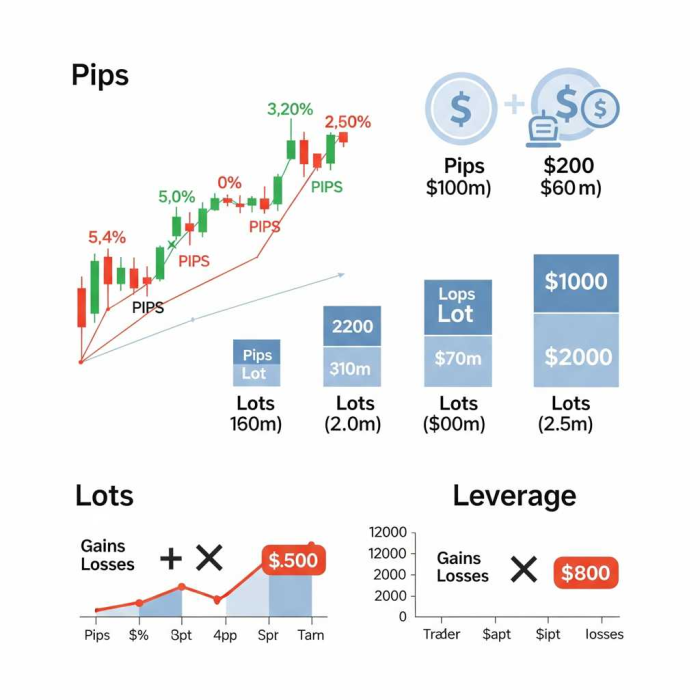Understanding Pips, Lots, and Leverage in Forex Trading
Forex trading can seem intimidating with its unique terminology. But understanding core concepts like pips, lots, and leverage is crucial for any aspiring trader. These three elements are fundamental to how profits and losses are calculated, and how much exposure you have in the market.

Let's break them down:
What is a Pip?
At its simplest, a pip (short for "percentage in point" or "price interest point") is the smallest unit of price movement in a currency pair.
For most currency pairs, a pip is the fourth decimal place. For example, if EUR/USD moves from 1.1050 to 1.1051, that's a one-pip increase.
There's an important exception: currency pairs involving the Japanese Yen (JPY). For these pairs, a pip is the second decimal place. So, if USD/JPY moves from 145.20 to 145.21, that's also a one-pip increase.
Understanding pips is vital because it's how you measure your profit or loss. The value of one pip depends on the currency pair and the size of your trade (which brings us to lots).
What is a Lot?
A lot is a standardized unit of transaction size in forex trading. It represents the number of currency units you are buying or selling. There are typically three main types of lots:
- Standard Lot: 100,000 units of the base currency.
- Mini Lot: 10,000 units of the base currency.
- Micro Lot: 1,000 units of the base currency.
The larger your lot size, the more significant the value of each pip movement. For example, if you're trading a standard lot of EUR/USD, a one-pip movement is typically worth $10. With a mini lot, it's $1, and with a micro lot, it's $0.10.
Choosing the appropriate lot size is a critical aspect of risk management. Trading with lot sizes that are too large for your capital can lead to significant losses very quickly.
What is Leverage?
Leverage is a double-edged sword in forex trading. It allows traders to control a much larger position in the market with a relatively small amount of capital. Essentially, your broker lends you the additional funds needed to open a larger trade.
Leverage is expressed as a ratio, such as 1:50, 1:100, or even 1:500.
- If you have 1:100 leverage, it means that for every $1 of your own capital, you can control $100 worth of currency in the market. So, with $1,000 in your trading account, you could open a position worth $100,000 (a standard lot).
While leverage can amplify your profits, it can also magnify your losses. A small adverse price movement, when combined with high leverage, can quickly deplete your trading account. This is why careful risk management and understanding margin requirements are paramount when using leverage.
The Relationship Between Pips, Lots, and Leverage
These three concepts are intrinsically linked:
- Your lot size determines the monetary value of each pip movement.
- Leverage allows you to trade larger lot sizes than your initial capital would otherwise permit.
Example Scenario:
Let's say you want to trade EUR/USD, and your broker offers 1:100 leverage.
- You identify a trade: You believe EUR/USD will rise from 1.1050.
- You decide on a lot size: You choose to open a standard lot (100,000 units).
- Leverage comes into play: To open a 100,000-unit position with 1:100 leverage, you would need $1,000 of your own capital as margin (100,000 / 100 = 1,000).
- Price moves: If EUR/USD moves up by 50 pips to 1.1100.
- Calculating profit: Since a standard lot of EUR/USD means each pip is worth $10, a 50-pip gain would result in a profit of $500 (50 pips * $10/pip).
As you can see, even a small price movement can result in substantial gains or losses due to the combined effect of lot size and leverage.
Final Thoughts
Pips, lots, and leverage are the building blocks of forex trading. A solid understanding of each, and how they interact, is essential for developing a sound trading strategy and managing your risk effectively. Always prioritize risk management and never over-leverage your trading account. Start small, understand the mechanics, and gradually increase your exposure as your experience and confidence grow. Happy trading!
Popular Tags